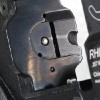No larger pictures, for some reason, but this is what it's supposed to look like, for reference

It appears your crack started at the lower inside corner of the ratchet/pawl slot...which should probably have been radiused, given its proximity to the firing pin hole (and edge of shield on the opposite side of that.)
When fired, the whole breachface is pushed back by the case head, doming the part slightly for a moment. If you look, the relief cut for the timing studs and ratchet notch (which incidentally coincides with the edges of that relief cut) greatly reduces the material thickness and 'meat' of the left side of the shield. At least, compared to the solid chunk of metal on the opposite side. Which means that whatever deflection occurs is disproportionately felt on the weaker side.
This is important for the purposes of fatigue. It's not enough to simply make something strong enough if it's to last many cycles; it has to dissipate stresses
gradually, or the areas where it does not will begin shearing at the atomic level --in the form of micro cracks.
The edge of any cutout or hole is a concentrating factor (firing pin and slot)
An inside corner, even round, is a concentrating factor (relief cut)
A sharp inside corner is a severe concentrating factor (ratchet slot)
The coincidence of two or more stress risers is a concentrating factor
The edge of a surface is a concentrating factor (lower edge)
An adjacent area of much greater stiffness is a concentrating factor (opposite side)
An awful lot of things seem to be working in the direction of crack propagation, here. It's still surprising that enough deflection could be delivered to the 3/16" or so thick plate to fatigue it to failure like this, even after thousands of rounds. Steel tends to be much better about cracking than, say, aluminum, but if it is extremely hard there's nothing stopping it once it gets started. I suspect these plates are extremely hard since they are solely an impact surface, and intuition would suggest that is desirable. For a flat plate it is, but that slot with the sharp corners really makes me wonder.
We'll have a better idea when you post a picture of the crack interface; we'll be able to readily see an inclusion (probably), whether the cracks were gradual or catastrophic, and possibly where they emanate from (my money's on the lower edge of the slot)
TCB







